Venus didn’t rise, Mars wasn’t in retrograde, the universe aligned with Karmic benevolence, nightfall brought the rains, the sun rose, the winds stilled and I captured a perfectly attuned shot for the first time in weeks.
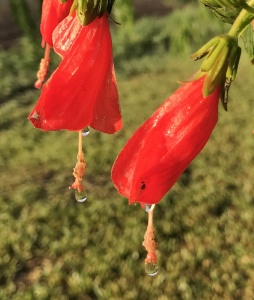
My early morning trek was muddy. I didn’t complain — the shoes will clean. San Benito savored a full inch of rain overnight making the planned and unplanned plants happy and vibrant.
If you’ve kept up with my blogs, you’ll know that I particularly like native plants that feed critters.
(Page numbers provided below refer to the Dr. Richardson/Ken King Plants of Deep South Texas book.)
Turk’s cap, Malvaviscus drummondii, (page 313) blooms feed butterflies and humming birds and the leaves are host to Turk’s cap white-skipper and mallow scrub-hairstreak butterflies.
Barbados cherry, also called manzanita, Malpighia glabra, (page 301) is for the birds although the leaves host larvae of some of the skippers and blues butterflies. Pretty red fruit comes along after the blooms. It’s been said that the vitamin C content of the fruit is the highest among our edible native plants. Lucky is the human who can get to the fruit before the birds.
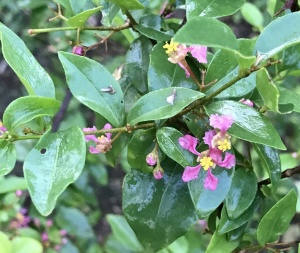
One of our most exotic-looking native trees is the coral bean, Erythrina herbacea, (page 261). The bottom spikes of the flower spears have begun pushing forth. Just about the only life form to use this unique but poisonous tree seems to be humming birds for nectar. I planted it for the artful creativity it brings to the garden. It puts on another show in the fall when the seed pods split open and reveal the bright red seeds. It’s tremendously easy to propagate from its highly-toxic-if-ingested seeds. I once successfully grew nine coral bean plants from seeds I’d collected. It was a proud moment indeed, but in the end, what does one do with so many poisonous plants?
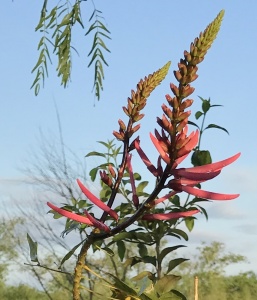
Snapdragon vines are really fun. Maurandya antirrhiniflora (page 387). They’re awfully prolific. Ours has draped itself over a retaining wall. When these vines get to be too much, they’re easy to pull out. They’re just as easy to pot up and share with friends. Great nectar source for butterflies and host plant to the common buckeye butterfly.
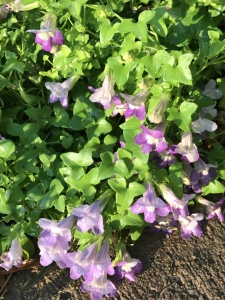
On the unplanned side of things, the white “scorpion tails” of Heliotrope, Heliotropium angiospermum, (page 144) are coming up everywhere. This is an excellent butterfly nectar plant, especially for small butterflies. It easily propagates (with the wind, I suspect) and keeps blooming far into the fall. If you find too many of these plants have pushed up into your garden, it’s best to pull them up when they’re quite small. After a couple month’s growth, they can become shrub-like with thick trunks. The roots really dig into the ground.
Coreopsis, or golden wave, Coreopsis tinctoria, Asteraceae (Compositae) family, (page 94) on the other hand, seems to just hang around for show, although I’ve read birds will eat the seeds. The Asteraceae family encompasses more than 23,600 species of herbs, shrubs and trees throughout the world. It is one of the largest plant families and includes coreopsis, daisies, sunflowers — the list goes on.
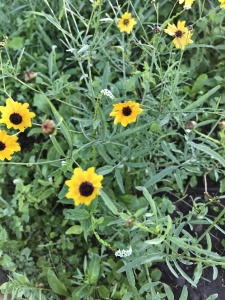
And who doesn’t like a sunflower? I’m going to hazard a guess and call the many lining the farmer’s field along our property line common sunflower, or mirasol, Helianthus annuus, (page 105). Certainly food for many birds including bobwhite quail, mourning doves and white-winged doves. Sunflowers also are some of the best butterfly nectar plants. Chachalacas eat the leaves.
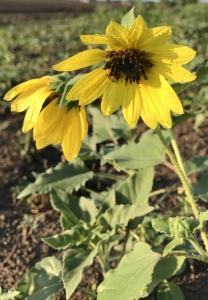
Silver leaf nightshade, Solanum eleagnifolum, (page 400) is springing up along the farmer’s field as well. Although somewhat muddy and windblown from the previous night’s storm, it’s one of my favorites because it just keeps on keeping on. The blooms turn into big berries that feed the birds. Bobwhite quail eat the seeds. As a caution, it’s not uncommon to see the word, deadly, prefacing the word nightshade. If your nightshade plants are not white potatoes, tomatoes, bell or hot peppers, eggplant or tomatillos, leave them in the field for the critters.
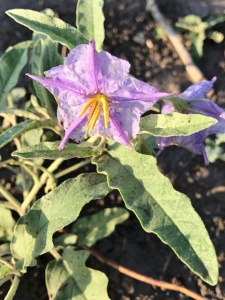
New this year at the disturbed edge between our property and the field are hundreds of wee starts of South Texas sand scorpionweed, Phacelia patuliflora var. austrotexana, (page 282). It has special value to native bees according to some brief research. Check out the lavender anthers — how cool is that?
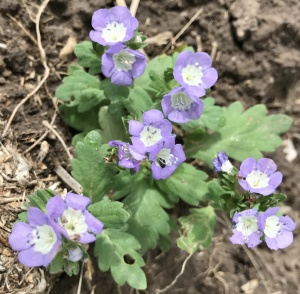
I’m always interested to know how our native plants help wildlife. If you have anything to add about these plants, please share.
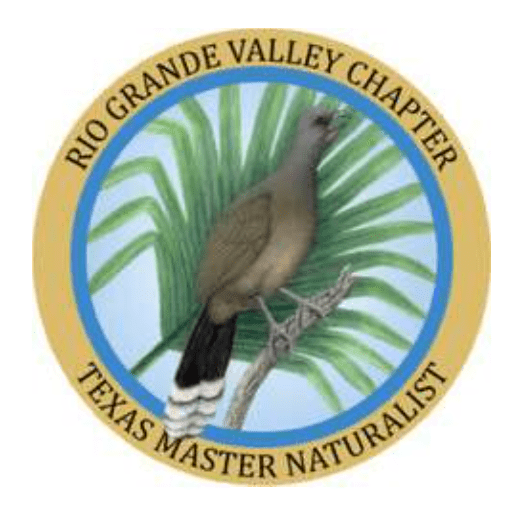
Leave a Reply